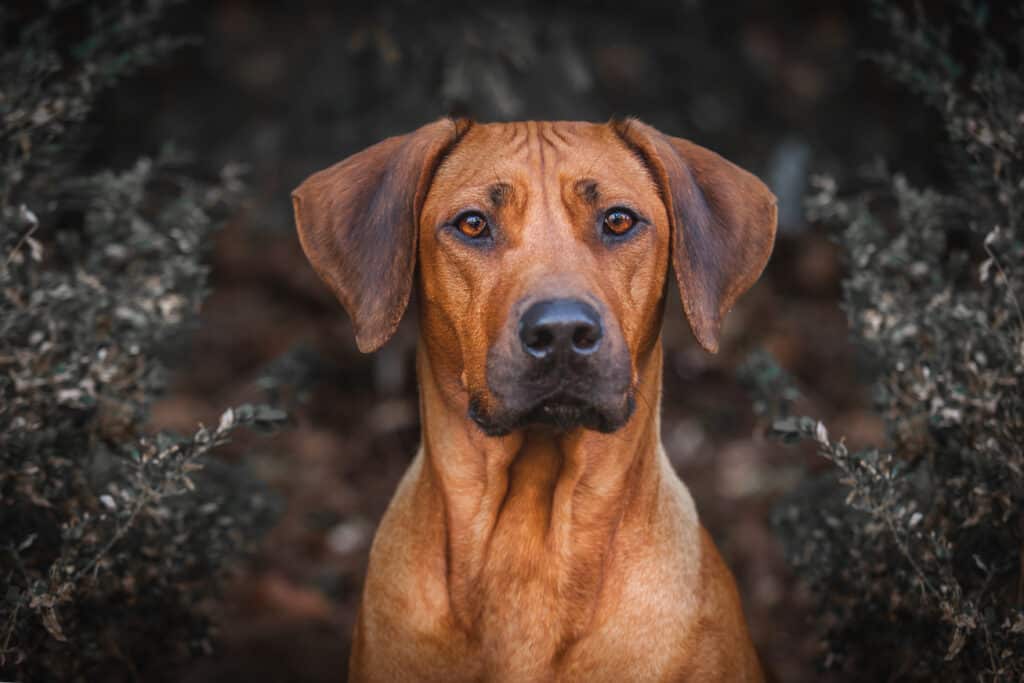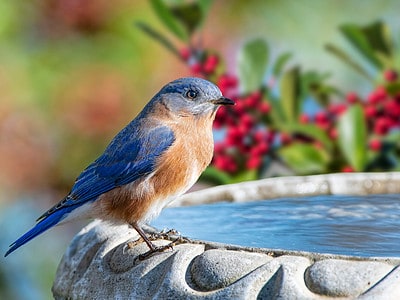Rhodesian Ridgeback
Canis lupus
Advertisement
Rhodesian Ridgeback Scientific Classification
- Kingdom
- Animalia
- Phylum
- Chordata
- Class
- Mammalia
- Order
- Carnivora
- Family
- Canidae
- Genus
- Canis
- Scientific Name
- Canis lupus
Read our Complete Guide to Classification of Animals.
Rhodesian Ridgeback Conservation Status
Rhodesian Ridgeback Facts
- Name Of Young
- Puppies
- Most Distinctive Feature
- Ridge backwards fur on spine
- Temperament
- Strong-willed, loyal
- Litter Size
- 8-10 puppies
View all of the Rhodesian Ridgeback images!
The mighty Rhodesian ridgeback is an unmistakable hound dog, identifiable for the ridge of striping fur along the spine. The breed originated in Africa, descending from a cross of Dutch imported Boers and other hunting dogs with the native African Khoikhoi dog. Over generations, the dogs were raised for tracking and baying – but not killing – lions while on the hunt. The resulting ridgeback hounds inherited a resiliency to local bugs and pests and the brains to outsmart their predators.
These days, Rhodesian ridgebacks are lovable family members, albeit with a strong prey drive and impressive independence. These powerful athlete dogs come in a limited variety of wheat-like colors, from beiges and flaxes to muted russet reds. Ridgebacks are sometimes strong-willed, bred as they are to work as a teammate on the hunt. As such, they require a firm but loving hand in training from the time they’re puppies. With firm training and affection, ridgebacks become faithful, caring family members who will gladly cuddle with those they trust.
Read on to learn more about the Rhodesian ridgeback and what to know before considering adding one to your family.
In the 19th century, Cornelius van Rooyen of modern-day South Africa incorporated Greyhounds into his pack of lion dogs and found their offspring to excel at confronting and baying lions and other predators.
The Best Dog Food For Rhodesian Ridgeback
The Rhodesian ridgeback’s muscley mass and moderate energy levels demand high-quality dog food that keeps your pup in healthy, happy shape. These dogs do best with a recipe with clean ingredients and formulations well-suited to the appropriate age in your dog’s life cycle, whether puppy or senior.
A high-protein diet with real animal meat will help your pup build and maintain muscle mass, while omega-3 fatty acids and vitamins help support healthy joints, skin, and fur. We at A-Z Animals recommend Blue Buffalo Wilderness Chicken Recipe Grain Free dog food, given the recipe’s rich blend of chicken-sourced protein, healthy fats, and antioxidants and minerals formulated to keep your pup healthy for years to come.
Ridgebacks can be known to pack on the pounds, so it’s essential to keep an eye on your pup’s food intake to manage weight levels. Some are notorious for sneaking and stealing their human’s food off the counter – best not to leave your ridgeback alone with your dinner.
While treats are handy for training as positive reinforcement, overindulging can cause obesity in your Rhodesian ridgeback. Be sure to use goodies sparingly; breaking a larger piece into smaller pieces is just as effective.
3 pros and cons of owning a Rhodesian Ridgeback
| Pros! | Cons! |
| Highly intelligent and easily trainable These smart pups are eager to please and can intuit commands. | Independent and strong-willed Trainers need to assert themselves as the pack’s leader with a patient training regiment. |
| Loyal watchdogs Ridgebacks make for excellent family dogs and protectors. | Strong prey drive You must keep your Rhodesian on leash when not in a safe, enclosed area. |
| Healthy with low medical maintenance This breed has no common health issues. | Puppies can get toothy These dogs need early training to avoid nipping, though they usually grow out of it. |
Rhodesian Ridgeback Size and Weight
Female Rhodesian ridgebacks sport medium heights, with averages between 24-26 inches, while males reach about an inch taller. The average weight of a male Rhodesian ridgeback is 86 pounds, while the more trim females weigh around 71 pounds at maturity.
| Height (Male) | 27’ Tall |
| Height (Female) | 26’ Tall |
| Weight (male) | 86lbs, fully grown |
| Weight (female) | 71lbs, fully grown |
Rhodesian Ridgeback Common Health Issues
While ridgebacks are generally healthy, responsible breeders should check their stock for hip and elbow dysplasia, thyroid health, and potential eye issues. Rhodesian ridgebacks can inherit these joint or hormonal issues, so proper testing is necessary for preventative health.
Ridgebacks can also be born with dermoid sinus, a tube-like opening that rarely appears at birth that affects breathing; breeders can usually feel for this defect.
Rhodesian Ridgeback Temperament
Rhodesian ridgebacks are affectionate, gentle dogs to their family, though they often are independent and single-minded. While rarely aggressive, these dogs have a strong prey drive and will chase animals if they perceive them as prey. Most of the time, they’re compatible with other dogs, especially when raised together from an early age. In doggy disagreements, they’ll stand their ground and won’t back down from a fight, particularly with dogs of the same gender. As such, you should supervise your dog when introducing him to new friends.
Ridgebacks can also be highly effective guard dogs, barking to alert their people of dangerous or suspicious situations, but they never bite or attack unless they’re provoked.
How To Take Care of Rhodesian Ridgeback

These dogs are devoted companions, thriving on quality time with their families.
©nik174/Shutterstock.com
These strong-willed dogs require clear, firm leadership to raise them into happy, securely attached animals. With minimal grooming, plenty of exercise, and socialization, your Rhodesian ridgeback will be a constant, loyal companion for the rest of your days together.
Maintenance And Grooming
The Rhodesian ridgeback sheds mildly with generally lowkey grooming needs. A weekly brushing will keep the coat clean and remove loose hair or dirt, and an occasional bath will keep your pup stink-free. Regularly trim down your dog’s nails if they’re not worn down naturally, as too-long nails can make your pup uncomfortable and cause walking issues.
Training
Due to their prey drive, ridgebacks should be kept on a leash at all times unless in a safely enclosed area. These dogs are devoted companions, thriving on quality time with their families. However, trainers must guide ridgeback’s strong will and independence from an early age with a firm hand. Early training, socialization, and even puppy classes will use positive reinforcement to help your dog grow into a well-mannered, at-ease companion.
Exercise
The athletic Rhodesian ridgeback requires moderate levels of exercise, though they adapt well to various living environments so long as they’re provided with regular walks and play sessions. They love to run and thrive on physical activity to keep them happy and healthy. Rhodesian ridgebacks excel at dog sports such as agility, tracking, and lure coursing.
Puppies
Puppy ridgebacks require lots of patients and a consistent, positive-reinforcement training schedule to avoid them developing into domineering, bossy dogs. The breed can be nippy as a puppy, so early training them to prevent biting is essential. Rhodesian ridgebacks are highly intelligent and can easily understand direction from their owners; if they’ve established themselves as the strong leader of the pack, that is. Early socialization, particularly with children and other family members, can help them become at ease with new situations and comfortable meeting new people.
Rhodesian Ridgeback And Children
Rhodesian ridgebacks adore children and are great family dogs. These dogs are ideal companions for kids who love the great outdoors and will happily accompany children on hikes or camping trips. However, they can be somewhat over-rambunctious for toddlers and may accidentally step on or crush a small child if not supervised.
Dogs similar to Rhodesian Ridgeback
The Rhodesian Ridgeback is closely related to other larger prey-driven dogs, including the boerboel, Great Dane, and Thai ridgeback.
- Boerboel: Ridgebacks are descended from the same gene pool as these hunting dogs.
- Great Dane: The Great Dane is another hunting breed with a strong prey drive and plenty of independence.
- Thai Ridgeback: These dogs share similar “ridge” markings along the spine with Rhodesian ridgebacks.
Popular Names for Rhodesian Ridgeback
Popular names for Rhodesian Ridgeback dogs include:
- Nala
- Lucy
- Max
- Charlie
- Penny
- Cooper
Up Next
View all 114 animals that start with RRhodesian Ridgeback FAQs (Frequently Asked Questions)
Is a Rhodesian ridgeback a good family dog?
Ridgebacks are excellent guard dogs and will loyally protect their children and other pack members. Rhodesian ridgebacks make for wonderful family dogs, but kids and the pup must learn how to behave in one another’s company. These larger dogs might accidentally knock small children over, so proper etiquette and training are necessary for both parties.
How rare is a Rhodesian ridgeback?
These dogs are still a relatively rare breed, with about 2,000 AKC registrations each year. Several reputable breeders are current members of the Rhodesian Ridgeback Club of the United States.
How long do Ridgeback dogs live?
The average lifespan of these dogs ranges from 10-12 years, though healthy dogs often outlive this estimate.
Thank you for reading! Have some feedback for us? Contact the AZ Animals editorial team.
Sources
- American Kennel Club / Accessed November 5, 2022
- Rhodesian Ridgeback Club of United States / Accessed November 5, 2022
- Purina / Accessed November 5, 2022


















